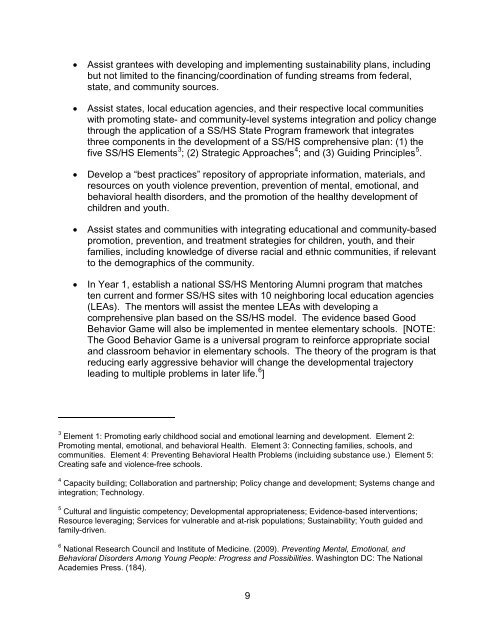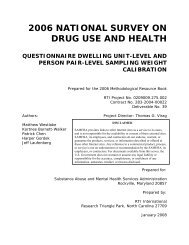Download Complete RFA Announcement (PDF | 351 KB)
Download Complete RFA Announcement (PDF | 351 KB)
Download Complete RFA Announcement (PDF | 351 KB)
Create successful ePaper yourself
Turn your PDF publications into a flip-book with our unique Google optimized e-Paper software.
• Assist grantees with developing and implementing sustainability plans, including<br />
but not limited to the financing/coordination of funding streams from federal,<br />
state, and community sources.<br />
• Assist states, local education agencies, and their respective local communities<br />
with promoting state- and community-level systems integration and policy change<br />
through the application of a SS/HS State Program framework that integrates<br />
three components in the development of a SS/HS comprehensive plan: (1) the<br />
five SS/HS Elements 3 ; (2) Strategic Approaches 4 ; and (3) Guiding Principles 5 .<br />
• Develop a “best practices” repository of appropriate information, materials, and<br />
resources on youth violence prevention, prevention of mental, emotional, and<br />
behavioral health disorders, and the promotion of the healthy development of<br />
children and youth.<br />
• Assist states and communities with integrating educational and community-based<br />
promotion, prevention, and treatment strategies for children, youth, and their<br />
families, including knowledge of diverse racial and ethnic communities, if relevant<br />
to the demographics of the community.<br />
• In Year 1, establish a national SS/HS Mentoring Alumni program that matches<br />
ten current and former SS/HS sites with 10 neighboring local education agencies<br />
(LEAs). The mentors will assist the mentee LEAs with developing a<br />
comprehensive plan based on the SS/HS model. The evidence based Good<br />
Behavior Game will also be implemented in mentee elementary schools. [NOTE:<br />
The Good Behavior Game is a universal program to reinforce appropriate social<br />
and classroom behavior in elementary schools. The theory of the program is that<br />
reducing early aggressive behavior will change the developmental trajectory<br />
leading to multiple problems in later life. 6 ]<br />
3 Element 1: Promoting early childhood social and emotional learning and development. Element 2:<br />
Promoting mental, emotional, and behavioral Health. Element 3: Connecting families, schools, and<br />
communities. Element 4: Preventing Behavioral Health Problems (incluiding substance use.) Element 5:<br />
Creating safe and violence-free schools.<br />
4 Capacity building; Collaboration and partnership; Policy change and development; Systems change and<br />
integration; Technology.<br />
5 Cultural and linguistic competency; Developmental appropriateness; Evidence-based interventions;<br />
Resource leveraging; Services for vulnerable and at-risk populations; Sustainability; Youth guided and<br />
family-driven.<br />
6 National Research Council and Institute of Medicine. (2009). Preventing Mental, Emotional, and<br />
Behavioral Disorders Among Young People: Progress and Possibilities. Washington DC: The National<br />
Academies Press. (184).<br />
9
















